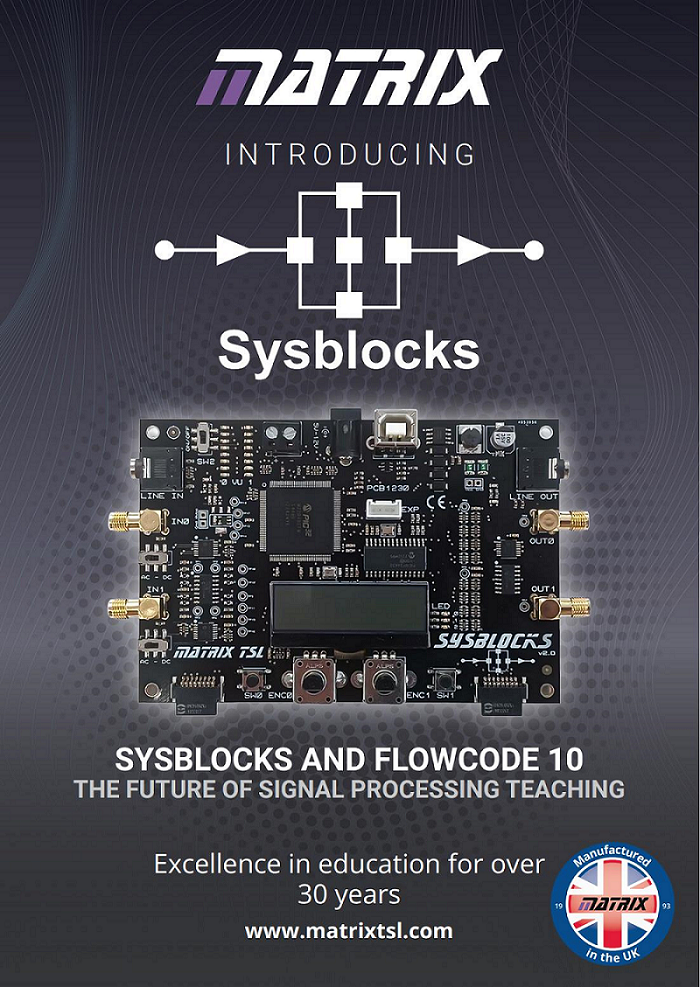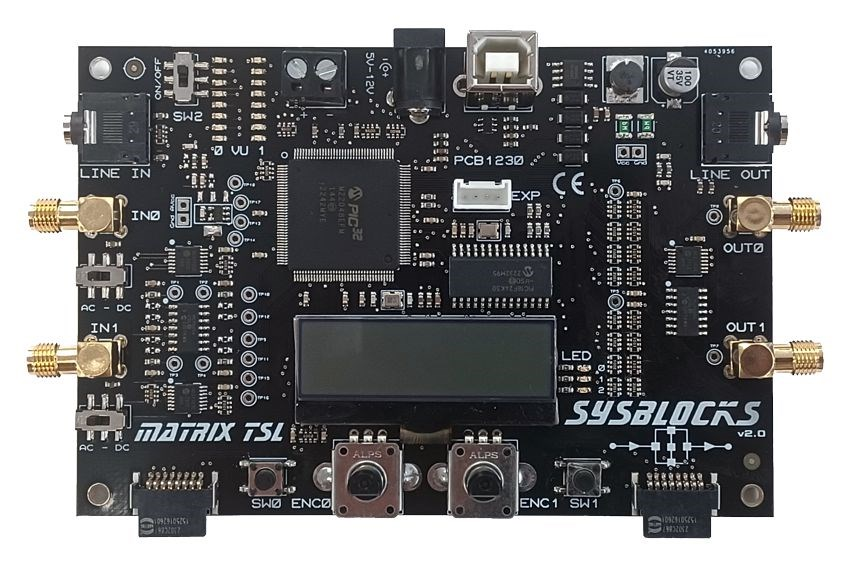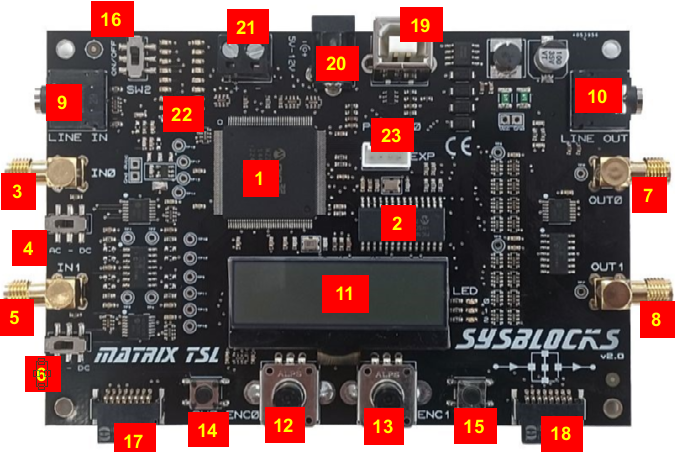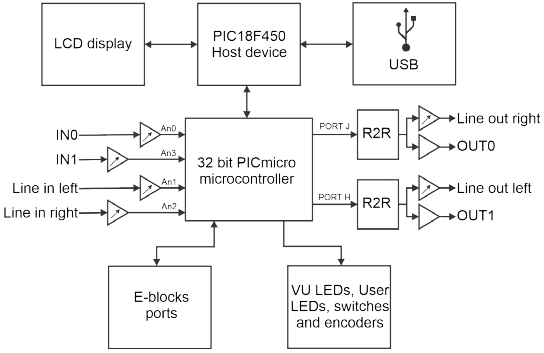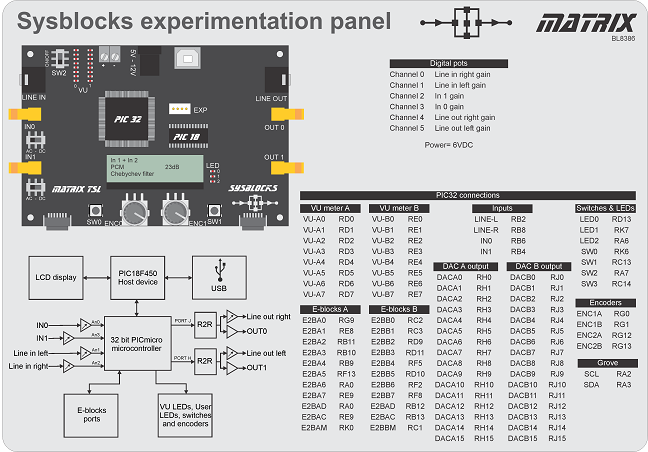Difference between revisions of "Sysblocks Getting Started Guide"
(Created page with "__TOC__ File:SysblocksGSG1.png ==Introduction to Sysblocks == File:SysblocksGSG2.png Sysblocks and Flowcode 10 provide a new way of teaching about signal processin...") |
|||
| Line 11: | Line 11: | ||
'''Hardware:''' | '''Hardware:''' | ||
| − | The opportunity of developing a product like Sysblocks is facilitated by the advent of advent of low cost high speed, high power microcontrollers - in this case a 32bit PICmicro microcontroller. | + | The opportunity of developing a product like Sysblocks is facilitated by the advent of advent of low cost high speed, high power microcontrollers - in this case a 32bit PICmicro microcontroller. The Sysblock hardware topology is very simple: Input buffer …..A/D….processor...D/A….output amplifer. |
| − | |||
| − | The Sysblock hardware topology is very simple: Input buffer …..A/D….processor...D/A….output amplifer. | ||
Sysblocks boards also include two E-blocks II boards so that students can use a wide variety of expansion boards from Matrix, Grove, Mikroelektronika and others. | Sysblocks boards also include two E-blocks II boards so that students can use a wide variety of expansion boards from Matrix, Grove, Mikroelektronika and others. | ||
| Line 67: | Line 65: | ||
15. Input switch SW1 | 15. Input switch SW1 | ||
</pre> | </pre> | ||
| + | |||
| + | ==Hardware: block diagram== | ||
| + | |||
| + | [[File:SysblocksGSG4.png]] | ||
| + | |||
| + | Sysblocks has four analogue inputs, two analogue outputs and support circuitry. | ||
| + | |||
| + | At the heart of the system is a very powerful 32 bit Micro chip PICmicro microcontroller running at 200MHz. This is capable of standard microcontroller type functions and also is capable of Digital Signal Processing the incoming audio signals. The 32 bit processor has a Coremark of 652 (around 330 Drystone MIPS) which is more than fast enough for the signal processing tasks involved for learning about Music technology, Digital Signal Processing and Modern communications theory. | ||
| + | |||
| + | The 32 bit PICmicro microcontroller is programmed by a host device which is a standard 18 series PICmicro microcontroller. This host device takes care of non-core tasks like USB communications, LCD display, encoder and switch inputs. This architecture keeps the main 32bit device free for signal processing. | ||
| + | |||
| + | Two E-blocks ports are made available for expansion. E-block boards for Wifi, keypad, Bluetooth, CAN, Zigbee and many other functions are available. This gives huge flexibility to the Sysblocks system as a wide range of projects can be built around it. A Grove connector is also available which allows users to access the wide range of Grove accessories. | ||
| + | |||
| + | The analogue input signals are buffered and level shifted to half of the supply voltage – 1.65V – and then fed to the internal A to D converters of the main 32 bit PICmicro microcontroller. A digital potentiometer allows the level of the input signals to be adjusted in software. | ||
| + | |||
| + | The microcontroller processes the digital signals and feeds the results to 2 x external R2R ladder DACs which are buffered by operational amplifier circuits. Line out left and right include a digital potentiometer that allows the output level to be adjusted in software. | ||
| + | |||
| + | The board is fitted with a number of switches and encoders for control purposes. The board also has a miniature monochrome graphical display and a number of programmable LEDs including 2 x 8 LED VU meter LEDs. | ||
| + | |||
| + | The board is powered from 3.3V from USB or from a plug top power supply. | ||
| + | |||
| + | <pre> | ||
| + | · Vin max 2.2V pk to pk | ||
| + | · Vout max 2.2V pk to pk | ||
| + | </pre> | ||
| + | |||
| + | ==Hardware: Sysblocks products== | ||
| + | |||
| + | [[File:SysblocksGSG5.png|left]] | ||
| + | BL8386 is our standard Sysblocks | ||
| + | |||
| + | experimentation panel. | ||
| + | |||
| + | It consists of a single | ||
| + | |||
| + | Sysblocks board on a plastic | ||
| + | |||
| + | panel with power supply and | ||
| + | |||
| + | USB lead and is shipped | ||
| + | |||
| + | in a standard tray for storage. | ||
| + | |||
| + | The Sysblocks board is protected | ||
| + | |||
| + | with a clear acrylic cover | ||
| + | |||
| + | to make it more rugged in the lab. | ||
| + | |||
| + | |||
| + | Students use conventional oscilloscopes | ||
| + | |||
| + | and spectrum analysers to examine the results of | ||
| + | |||
| + | signal processing in a music and DSP context. | ||
Revision as of 10:38, 28 November 2023
Contents
Introduction to Sysblocks
Sysblocks and Flowcode 10 provide a new way of teaching about signal processing for Music technology, DSP, Communications and Software Defined Radio.
Hardware:
The opportunity of developing a product like Sysblocks is facilitated by the advent of advent of low cost high speed, high power microcontrollers - in this case a 32bit PICmicro microcontroller. The Sysblock hardware topology is very simple: Input buffer …..A/D….processor...D/A….output amplifer.
Sysblocks boards also include two E-blocks II boards so that students can use a wide variety of expansion boards from Matrix, Grove, Mikroelektronika and others.
Software:
Flowcode 10 software is a graphical programming solution for microcontrollers and PCs. Flowcode allows those with limited programming experience to develop complex electronic systems using graphical and conventional C code programming.
Curriculum: There are three separate curricula for Sysblocks and Flowcode 10:
- Music with microcontrollers
- Systems, signals, DSP, and FFT
- Communications and Software Defined Radio
The following information will explain to you how Sysblocks and Flowcode 10 can be used to provide fantastic learning opportunities in electronics.
Hardware: PCB overview
1. Fast 32 bit PIC processor 16. Input switch SW2 2. PIC18F24K50 control processor that handles 17. E-blocks II expansion port A the USB communications, 32 bit PIC programming, LCD display, encoders and input switches 18. E-blocks II expansion port B 3. SMA connector Input IN0 19. USB socket / power in 4. AC / DC coupling switch SW4 20. 2.1mm power jack, 5 - 12V 5. SMA connector Input IN1 21. Screw terminal power connector (input or output) 6. AC / DC coupling switch SW3 22. 2 x banks of 8 user programmable LEDs - for VU meters 7. SMA connector Output OUT0 23. Grove sensor expansion socket 8. SMA connector Output OUT1 9. 3.5mm jack stereo line in 10. 3.5mm jack stereo line out 11. 4 line monochrome LCD display 12. Rotary encoder input ENC0 13. Rotary encoder input ENC1 14. Input switch SW0 15. Input switch SW1
Hardware: block diagram
Sysblocks has four analogue inputs, two analogue outputs and support circuitry.
At the heart of the system is a very powerful 32 bit Micro chip PICmicro microcontroller running at 200MHz. This is capable of standard microcontroller type functions and also is capable of Digital Signal Processing the incoming audio signals. The 32 bit processor has a Coremark of 652 (around 330 Drystone MIPS) which is more than fast enough for the signal processing tasks involved for learning about Music technology, Digital Signal Processing and Modern communications theory.
The 32 bit PICmicro microcontroller is programmed by a host device which is a standard 18 series PICmicro microcontroller. This host device takes care of non-core tasks like USB communications, LCD display, encoder and switch inputs. This architecture keeps the main 32bit device free for signal processing.
Two E-blocks ports are made available for expansion. E-block boards for Wifi, keypad, Bluetooth, CAN, Zigbee and many other functions are available. This gives huge flexibility to the Sysblocks system as a wide range of projects can be built around it. A Grove connector is also available which allows users to access the wide range of Grove accessories.
The analogue input signals are buffered and level shifted to half of the supply voltage – 1.65V – and then fed to the internal A to D converters of the main 32 bit PICmicro microcontroller. A digital potentiometer allows the level of the input signals to be adjusted in software.
The microcontroller processes the digital signals and feeds the results to 2 x external R2R ladder DACs which are buffered by operational amplifier circuits. Line out left and right include a digital potentiometer that allows the output level to be adjusted in software.
The board is fitted with a number of switches and encoders for control purposes. The board also has a miniature monochrome graphical display and a number of programmable LEDs including 2 x 8 LED VU meter LEDs.
The board is powered from 3.3V from USB or from a plug top power supply.
· Vin max 2.2V pk to pk · Vout max 2.2V pk to pk
Hardware: Sysblocks products
BL8386 is our standard Sysblocks
experimentation panel.
It consists of a single
Sysblocks board on a plastic
panel with power supply and
USB lead and is shipped
in a standard tray for storage.
The Sysblocks board is protected
with a clear acrylic cover
to make it more rugged in the lab.
Students use conventional oscilloscopes
and spectrum analysers to examine the results of
signal processing in a music and DSP context.
